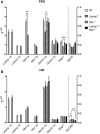Promoter-Specific Expression and Genomic Structure of IgLON Family Genes in Mouse
- PMID: 28210208
- PMCID: PMC5288359
- DOI: 10.3389/fnins.2017.00038
Promoter-Specific Expression and Genomic Structure of IgLON Family Genes in Mouse
Abstract
IgLON family is composed of five genes: Lsamp, Ntm, Opcml, Negr1, and Iglon5; encoding for five highly homologous neural adhesion proteins that regulate neurite outgrowth and synapse formation. In the current study we performed in silico analysis revealing that Ntm and Opcml display similar genomic structure as previously reported for Lsamp, characterized by two alternative promotors 1a and 1b. Negr1 and Iglon5 transcripts have uniform 5' region, suggesting single promoter. Iglon5, the recently characterized family member, shares high level of conservation and structural qualities characteristic to IgLON family such as N-terminal signal peptide, three Ig domains, and GPI anchor binding site. By using custom 5'-isoform-specific TaqMan gene-expression assay, we demonstrated heterogeneous expression of IgLON transcripts in different areas of mouse brain and several-fold lower expression in selected tissues outside central nervous system. As an example, the expression of IgLON transcripts in urogenital and reproductive system is in line with repeated reports of urogenital tumors accompanied by mutations in IgLON genes. Considering the high levels of intra-family homology shared by IgLONs, we investigated potential compensatory effects at the level of IgLON isoforms in the brains of mice deficient of one or two family members. We found that the lack of IgLONs is not compensated by a systematic quantitative increase of the other family members. On the contrary, the expression of Ntm 1a transcript and NEGR1 protein was significantly reduced in the frontal cortex of Lsamp-deficient mice suggesting that the expression patterns within IgLON family are balanced coherently. The actions of individual IgLONs, however, can be antagonistic as demonstrated by differential expression of Syp in deletion mutants of IgLONs. In conclusion, we show that the genomic twin-promoter structure has impact on both anatomical distribution and intra-family interactions of IgLON family members. Remarkable variety in the activity levels of 1a and 1b promoters both in the brain and in other tissues, suggests complex functional regulation of IgLONs by alternative signal peptides driven by 1a and 1b promoters.
Keywords: IgLON; IgLON5; KILON; LSAMP; NEGR1; NTM; OPCML; alternative promoters.
Figures






References
-
- Behan A. T., Byrne C., Dunn M. J., Cagney G., Cotter D. R. (2009). Proteomic analysis of membrane micro domain-associated proteins in the dorsolateral prefrontal cortex in schizophrenia and bipolar disorder reveals alterations in LAMP, STXBP1 and BASP1 protein expression. Mol. Psychiatry 14, 601–613. 10.1038/mp.2008.7 - DOI - PubMed
LinkOut - more resources
Full Text Sources
Other Literature Sources
Molecular Biology Databases
Research Materials

